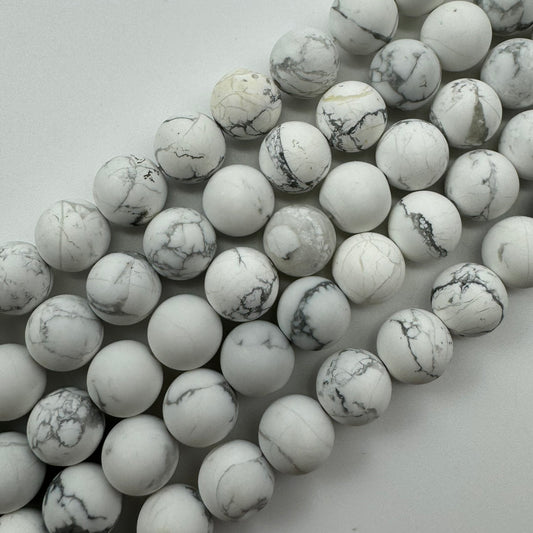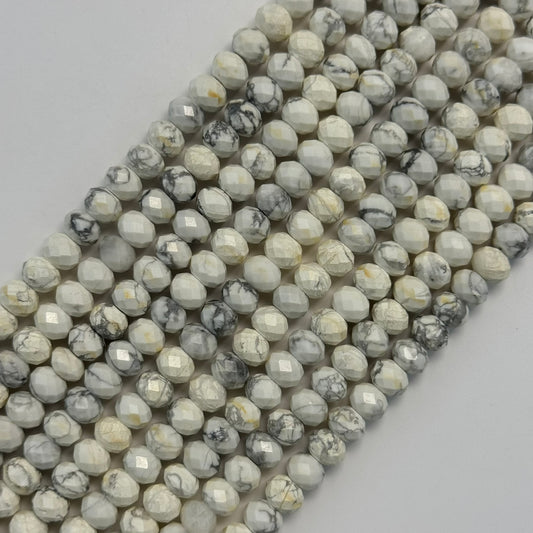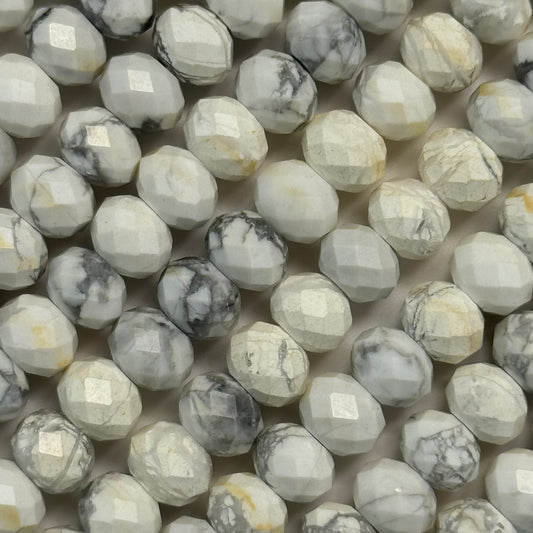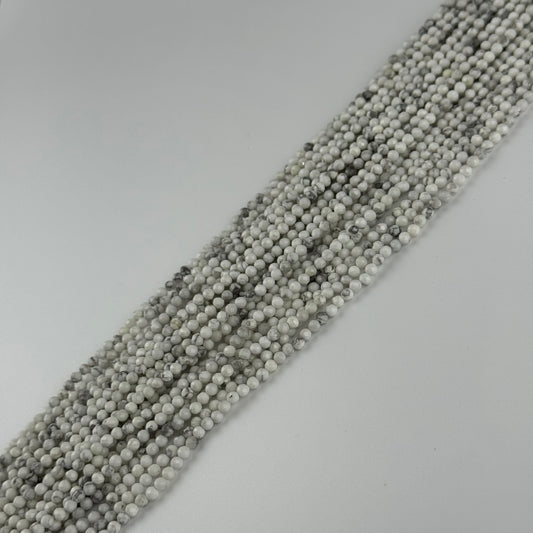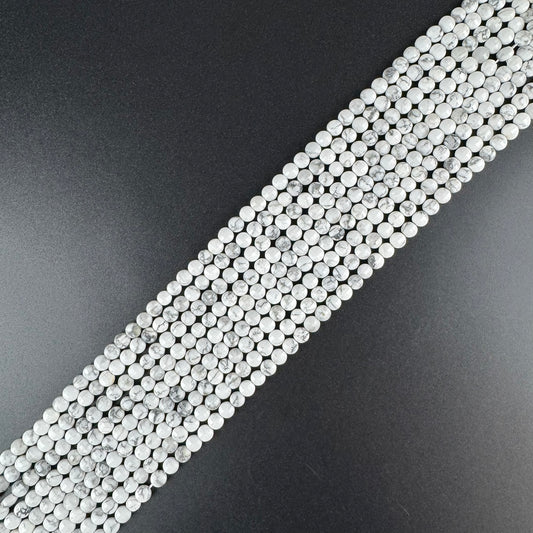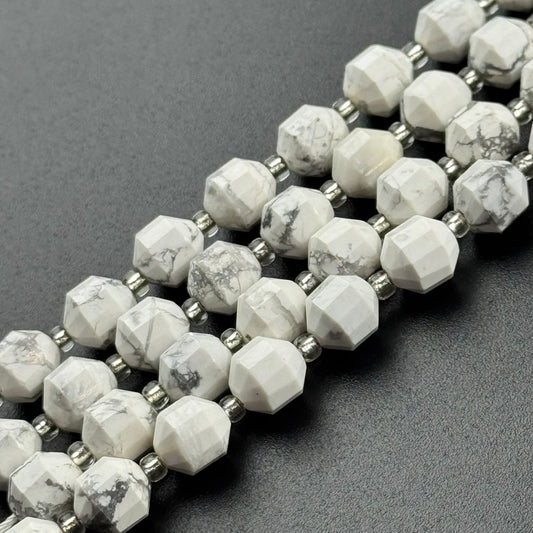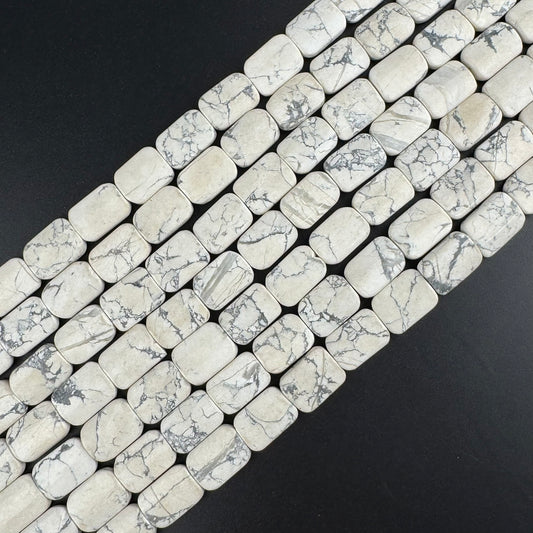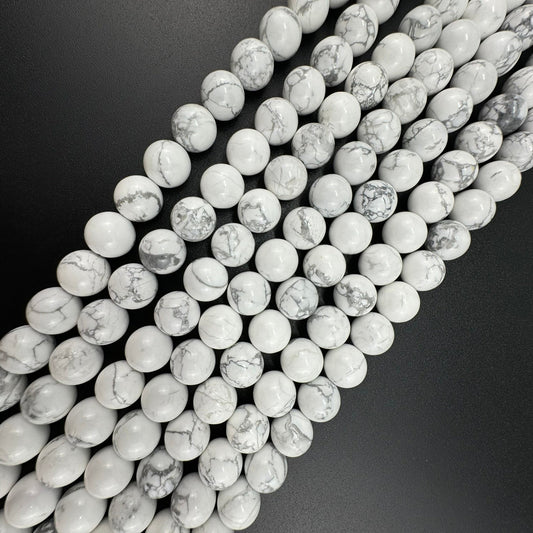Howlite Gemstone Beads
Howlite
Howlite is a borate mineral typically found in white or grayish hues with distinctive gray or black veining. It is widely appreciated for its calming energy and is often used as a decorative stone or in jewelry making. Its unique patterns make each piece visually distinct and attractive.
Beyond its aesthetic appeal, howlite is popular in metaphysical circles for its ability to soothe stress and promote patience and tranquility. It is a versatile mineral that is often dyed to imitate more expensive stones, especially turquoise.
Howlite Crystal
Howlite crystals form as nodules or masses rather than distinct crystal shapes, usually showing a fine-grained texture. These nodules often contain natural fissures filled with black or gray lines, which give the stone its signature marbled appearance.
Collectors and gem enthusiasts prize howlite crystals for their unique surface patterns and their use as a base for dyed stones. Although not commonly found in large, faceted crystal forms, howlite’s natural formations are highly valued in raw and polished states.
Howlite Meaning, Benefits, and Healing Properties
Howlite is believed to hold calming and soothing properties that can reduce anxiety, tension, and anger. It is often used in meditation to enhance awareness and promote emotional expression. Its gentle energy is thought to encourage patience and relieve insomnia.
In addition to its spiritual benefits, howlite is considered a stone that fosters communication and self-expression. Healers use it to balance emotions and foster peaceful relationships, making it a popular choice among those seeking emotional well-being.
White Howlite
White howlite is the most common form of howlite, naturally presenting in a white to gray color with contrasting veins that range from light gray to black. Its calming neutral tones make it a popular stone for use in minimalist jewelry and home decor.
The white variety is often left untreated to showcase its natural beauty or dyed to resemble turquoise. White howlite’s peaceful energy is associated with clarity of mind and is used to help slow down rapid thoughts and ease stress.
Is There Blue Howlite in the Gemstone Market?
Blue howlite is not naturally occurring but is widely available in the gemstone market as a dyed variety of white howlite. The vibrant blue color imitates turquoise and offers a more affordable alternative for jewelry designers and collectors.
Despite being dyed, blue howlite retains the calming metaphysical properties of natural howlite. Buyers should be aware of the difference between natural turquoise and dyed howlite when purchasing gemstones.
Howlite as Jewelry and Accessories
Howlite is frequently used in jewelry such as beads, bracelets, pendants, and earrings due to its unique veined appearance and easy workability. Its relatively soft hardness makes it simple to carve and polish into various shapes.
Because of its calming energy and aesthetic versatility, howlite jewelry is popular among those seeking both fashion and spiritual benefits. Whether natural or dyed, howlite pieces add a subtle elegance and meaningful symbolism to any accessory collection.
Turquoise vs Howlite
Turquoise is a naturally blue to green mineral prized for its historical and cultural significance, while howlite is a white or gray stone often dyed to mimic turquoise’s vibrant color. Both are popular in jewelry but differ significantly in origin and properties.
In terms of hardness, turquoise tends to be slightly harder than howlite, making it more durable. However, howlite offers an economical alternative with similar visual appeal when dyed, and it shares some metaphysical qualities with turquoise, such as promoting calmness and emotional balance.
Howlite Hardness
Howlite has a Mohs hardness rating of approximately 3.5, which makes it relatively soft compared to many other gemstones. This softness means it can be scratched easily and should be handled with care, especially when used in jewelry.
Due to its low hardness, howlite jewelry is best suited for pieces like earrings or pendants that are less exposed to wear and tear. Proper care, including avoiding abrasive surfaces, helps maintain the stone’s polished appearance over time.
Howlite Chemical Composition
Howlite is a hydrous calcium borate mineral with the chemical formula Ca2B5SiO9(OH)5. This composition contributes to its unique physical properties and its distinctive white coloration with gray veining.
The presence of boron and calcium in its structure influences howlite’s formation and contributes to its relatively low hardness compared to silicate minerals. Its chemistry also allows it to absorb dyes effectively, which is why it is commonly used as a base for imitation turquoise.
Howlite Crystal Structure
Howlite crystallizes in the monoclinic crystal system, forming in nodules or masses rather than well-defined crystals. This structure results in its characteristic irregular patterns and the veining commonly seen on its surface.
The monoclinic symmetry influences how howlite breaks and its cleavage properties, making it prone to fracturing rather than forming large, flawless crystals. This structure also explains why howlite is commonly found in compact, rounded masses.
Howlite Formation Process
Howlite forms through the precipitation of borate minerals in evaporite deposits and in hydrothermal environments. It often forms in sedimentary rocks alongside other borate minerals.
The process involves the gradual accumulation and crystallization of boron, calcium, and silicate components, typically in low-temperature settings. This geological formation process leads to the distinctive nodular appearance and veining in howlite specimens.
Howlite Physical Properties
Howlite is a relatively lightweight mineral with a specific gravity of around 2.53. Its physical characteristics include a smooth texture, white to gray coloration, and gray or black veining that creates a marbled effect.
Because it is porous, howlite can absorb dyes easily, which is why it is often artificially colored. Its softness and brittleness require careful handling during cutting and polishing.
Howlite Optical Properties
Howlite typically exhibits a vitreous to sub-vitreous luster with a translucent to opaque transparency. Its unique veining patterns contribute to its visual appeal, making it popular in ornamental uses.
Under magnification, howlite shows a granular texture and internal fractures. Its refractive index ranges between 1.59 and 1.60, which is consistent with other borate minerals.
Howlite Specific Gravity
Howlite has a specific gravity of approximately 2.53, indicating it is relatively light compared to many other minerals. This low density makes it comfortable to wear in jewelry and easy to handle.
The specific gravity also helps differentiate howlite from similar-looking minerals, especially when testing for authenticity and identification in gemology.
Howlite Cleavage and Fracture
Howlite exhibits perfect cleavage in one direction, meaning it can split cleanly along specific planes. This property requires caution during cutting and setting in jewelry to prevent unwanted breaks.
Its fracture is usually uneven or conchoidal, contributing to its brittle nature. Understanding howlite’s cleavage and fracture is essential for jewelers and collectors when shaping or polishing the stone.
Frequently Asked Questions
What is howlite?
Howlite is a white or grayish borate mineral known for its distinctive veining and calming metaphysical properties. It is often used in jewelry and as a decorative stone.
What are the healing properties of howlite?
Howlite is believed to reduce stress, calm the mind, and promote patience. It is commonly used in meditation and emotional healing to balance emotions.
What does white howlite look like?
White howlite is typically white or light gray with natural gray or black veining that creates a marble-like appearance.
Is blue howlite natural?
No, blue howlite is not natural. It is white howlite that has been dyed to imitate turquoise or other blue stones.
How can you tell real howlite from fake?
Natural howlite shows natural veining and a porous texture, while fakes may look too uniform or smooth. Testing hardness and checking for dye can also help.
What is the hardness of howlite?
Howlite has a Mohs hardness of approximately 3.5, making it a relatively soft stone that requires careful handling.
Can howlite be used in jewelry?
Yes, howlite is popular in jewelry making for beads, bracelets, pendants, and earrings due to its unique look and calming properties.
How does howlite compare to turquoise?
Howlite is often dyed to mimic turquoise but is softer and chemically different. Turquoise is naturally blue-green, whereas howlite is naturally white or gray.
What is the chemical composition of howlite?
Howlite is a hydrous calcium borate with the formula Ca2B5SiO9(OH)5, giving it its characteristic properties.
Where is howlite found?
Howlite is primarily found in evaporite deposits in places like Canada, the United States (California), and parts of Europe.
What chakra is associated with howlite?
Howlite is most commonly associated with the crown chakra, helping to calm the mind and enhance spiritual awareness.
How do you care for howlite jewelry?
Howlite jewelry should be cleaned gently with a soft cloth and lukewarm water. Avoid harsh chemicals and prolonged exposure to water or sunlight.
Can howlite help with insomnia?
Yes, howlite is often used to calm an overactive mind and is believed to assist in reducing insomnia and promoting restful sleep.
What is the crystal structure of howlite?
Howlite crystallizes in the monoclinic system, typically forming nodules rather than distinct crystals.
Does howlite fluoresce under UV light?
Yes, some howlite specimens may show weak fluorescence under UV light, often a white or pale blue glow.
Can howlite be dyed other colors?
Yes, howlite is porous and is often dyed various colors like blue or green to imitate other gemstones.
What is howlite's specific gravity?
Howlite has a specific gravity of about 2.53, which makes it relatively lightweight compared to many other minerals.
Does howlite have cleavage?
Yes, howlite has perfect cleavage in one direction, meaning it can split easily along specific planes.
Is howlite toxic?
No, howlite is not toxic and is safe to wear as jewelry or use as a decorative stone.
Can howlite help with emotional balance?
Many believe howlite promotes emotional balance by calming anger, reducing anxiety, and fostering patience.
What colors does howlite naturally occur in?
Howlite naturally occurs in white to gray tones, often with dark veining. Other colors are typically the result of dyeing.
Is howlite good for meditation?
Yes, howlite is often used in meditation to calm the mind and open spiritual channels.
Can howlite be used for protection?
Some metaphysical traditions believe howlite can protect against negative energies and electromagnetic pollution.
What jewelry is commonly made from howlite?
Howlite is commonly made into beads, bracelets, rings, pendants, and earrings due to its versatility and calming energy.
How does howlite feel to the touch?
Howlite has a smooth, cool feel with a slightly porous texture due to its natural formation.
Is howlite suitable for everyday wear?
Due to its softness, howlite jewelry should be worn with care and is best suited for pieces that don’t experience rough wear.
Can howlite be combined with other stones?
Yes, howlite pairs well with stones like turquoise, amethyst, and quartz to enhance calming and spiritual properties.
What is the origin of the name 'howlite'?
Howlite was named after Henry How, a Canadian geologist who first identified the mineral in the 19th century.
How does howlite form geologically?
Howlite forms in evaporite deposits and hydrothermal environments, usually as nodules or masses rather than distinct crystals.
Is howlite used outside of jewelry?
Besides jewelry, howlite is also used for ornamental carvings, decorative objects, and in metaphysical healing practices.
What makes howlite unique among borate minerals?
Howlite is unique for its distinctive veining and its ability to absorb dyes, making it popular for imitation gemstones.

